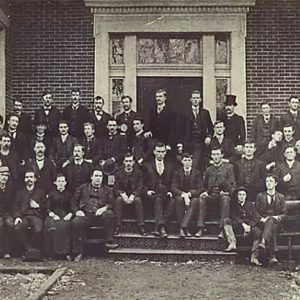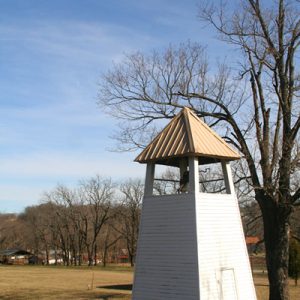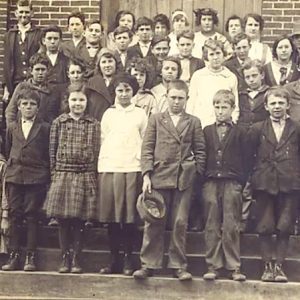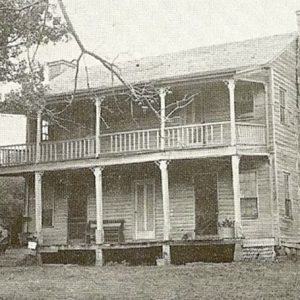calsfoundation@cals.org
Cane Hill College
Cane Hill College was chartered in 1850 as Cane Hill Collegiate Institute (CHCI) and was one of the earliest institutions of higher education in the state. Though burned by Union forces during the Civil War, the college was rebuilt and, in 1875, became a coeducational institution with the merger of a nearby Methodist female seminary. Though it closed its doors in 1891, the college had a large impact upon the area, and the surviving college building in Cane Hill (Washington County) was used as a public school until the 1950s and has served various community functions since that time.
The Cane Hill Congregation of the Cumberland Presbyterian Church was founded in 1828. Church members opened Cane Hill School in 1835. In 1850, the school moved south about three miles, just west of the current village of Cane Hill (then called Boonsboro), into a “substantial brick house of two rooms.” An act of the Arkansas General Assembly on December 26, 1850, created Cane Hill Collegiate Institute and gave it authority to grant undergraduate degrees. The faculty was composed of three members: Robert McGee King (superintendent), Samuel Doak Lowry, and Thomas G. McCollough. CHCI was under control of the Arkansas and Washington presbyteries of the Cumberland Presbyterian Church.
CHCI was chartered as Cane Hill College by an act of the Arkansas legislature on December 15, 1852. This was one day after the chartering of Arkansas College in Fayetteville (Washington County). Nominally, Cane Hill College was under the “management and control” of the Arkansas Synod of the Cumberland Presbyterian Church. However, the synod exercised little control and provided little or no funding. Superintendent King was re-titled as president. Lowry served as acting president from King’s resignation in 1856 to the arrival of the Reverend Fontaine Earle in 1859.
During King’s tenure, a bell from a sunken steamboat was acquired for the college. When the college was burned in 1864, the bell cracked, but it was sent to be re-cast. It was placed in a free-standing belfry that still stands beside the college building. A two-story frame building was erected in 1854. One story contained the “literary room” and the other the library. There was also a lower room that housed a physics laboratory. Church services and meetings were held in the literary room. A third building, the first brick structure, was completed in 1858, paid for by donations from the community. A fourth building a short distance from the main campus was funded by the Reverend Andrew Buchanan of Prairie Grove (Washington County).
In 1861, the college closed, and it remained so for the duration of the Civil War. After the Engagement at Cane Hill in November 1862, Union forces occupied the town for about two years. Following the occupation, virtually all of the Cane Hill buildings and residences (including the college) were burned by Union incendiaries. The building that was used as a dormitory was spared because it was being used as a Union hospital. The rebuilding of houses and other buildings started in 1865, with the college reportedly holding classes in the former dormitory. Earle resumed the presidency, assisted by James Mitchell. By 1868, a new building was constructed on the foundation of the large brick building. In 1875, the Methodist-controlled Cane Hill Female Seminary closed and became the “female division” of Cane Hill College. Graduating men were awarded a BA degree, but women were awarded an “equivalent degree.” The female division had a separate principal and was generally a preparatory program.
The college was again destroyed by fire in 1885, apparently by arson. Legend has it that the arsonist was a disgruntled bootlegger who had been asked to leave town. The following year, the college was again resurrected, this time in the form of a two-story brick building. This building is still standing at Cane Hill, though was modified and extensively repaired over the years. The second floor is an auditorium and was used as a sanctuary on Sundays.
Dwindling finances forced the college to close in about 1891. One major factor was the opening of Arkansas Industrial University, now the University of Arkansas (UA) in Fayetteville, in 1871. With the university only twenty miles away and offering (at that time) free classes, tiny Cane Hill College could not compete. In 1891, Arkansas Cumberland College opened. That college has always claimed roots in Cane Hill in 1834, but historian Robert H. Basham found no direct link when he wrote his history of Cane Hill College in 1969. After the closing of the college, Salem Congregation of the Cumberland Presbyterian Church continued to use the second floor as its sanctuary until 1919. At that time, the college building came to be used as a public school. The names of high school graduates are etched into the front sidewalk of the college building. The high school continued until the early 1940s, and a grade school until 1956, after which the building was largely unused. A serious restoration effort began in 1986, and a fundraising festival has been held every year since then (with the exception of 2020, when it was canceled due to the COVID-19 pandemic).
The college building was listed on the National Register of Historic Places on November 17, 1982. A $1.4 million renovation overseen by Historic Cane Hill Inc. and completed in the spring of 2017 returned the building to how it looked before a 1931 renovation. It was restored to serve as a space for meetings or events.
For additional information:
Basham, Robert H. “A History of Cane Hill College in Arkansas.” PhD diss., University of Arkansas, 1969.
Bowden, Bill. “At Cane Hill, Restored 1886 College Building Set to Open.” Arkansas Democrat-Gazette, May 12, 2017. Online at http://www.arkansasonline.com/news/2017/may/12/at-cane-hill-restored-1886-college-buil/ (accessed April 12, 2022).
Braly, William C. “History of Cane Hill College.” In Publications of the Arkansas Historical Association, vol. 3. Fayetteville, AR: 1911.
Campbell, Thomas H., et al. Arkansas Cumberland Presbyterians: 1812–1984: A People of Faith. Memphis: Frontier Press, 1985.
“Cane Hill College Building.” National Register of Historic Places nomination form. On file at Arkansas Historic Preservation Program, Little Rock, Arkansas. Online at http://www.arkansaspreservation.com/National-Register-Listings/PDF/WA0377.nr.pdf (accessed April 12, 2022).
McCulloch, Lacy P. History of Cane Hill College in Pictures and Words. Cane Hill, AR: ARC Press, 1989.
Pyszka, Kimberly. The Archaeology of Protestant Landscapes: Revealing the Formation of Community Identity in the US South. Tuscaloosa: University of Alabama Press, 2023.
Richardson, Ellen E. “Cane Hill Female Seminary.” Arkansas Historical Quarterly 4 (Winter 1946): 354–358.
Richardson, Ellen Earle. Early Settlers of Cane Hill, Arkansas. Cane Hill, AR: ARC Press, 1988.
David B. Ellis
Cane Hill, Arkansas
 Cane Hill Class
Cane Hill Class  Cane Hill College
Cane Hill College  Cane Hill College
Cane Hill College  Cane Hill College
Cane Hill College  Cane Hill College
Cane Hill College  Cane Hill College Dormitory
Cane Hill College Dormitory 




Comments
No comments on this entry yet.